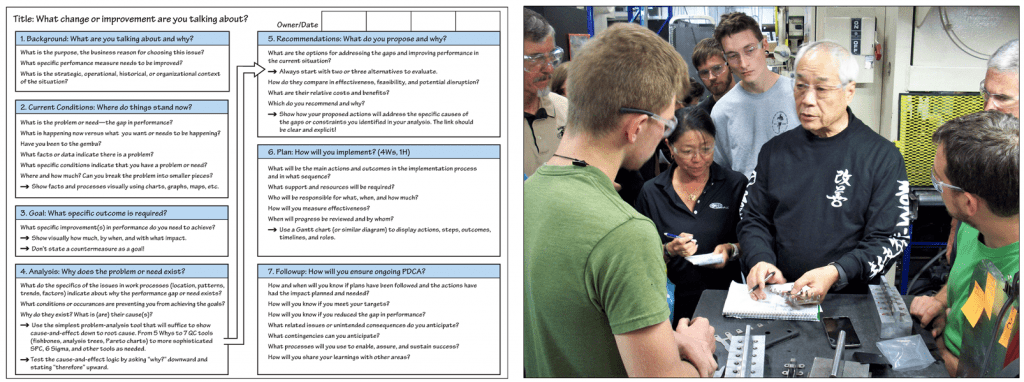
The emerging buzz these days is to expand the use of Toyota’s A3 reports from a tool to engage mid-level managers in improvement to a tool for changing business leaders beliefs and behaviors. Recent examples include “The Power of Personal Yokoten” to change beliefs and “Four Things to Remember When Working on Your Personal A3” to change behaviors. Is this a proper use of A3 reports? Does it work?
Changing leaders’ beliefs and behaviors is a notoriously difficult undertaking. Why, because leaders, at any level, lead de jure — meaning by right, rather than de facto — meaning, based on facts. The higher up one is in an organization, the more prevalent de jure is and facts become less important (click here to learn more about this). When top leaders lead by right, they possess a preconception-based view of reality rather than a sensory perception-based view of reality rooted in the facts. To get leaders to change, you must uproot them from their de jure, preconception-based reality and immerse them in a sensory perception-based reality rooted in the facts.
In Lean-world, the way we expose leaders to sensory perception-based reality is by getting them to participate in shop and office floor kaizens. These experiences break leader’s preconceptions (beliefs) and drives them towards new behaviors, which in, turn, results in new competencies based on facts. But there is a problem: Most leaders will not participate in genba kaizen. The culture of the institution of leadership is to lead based on preconceptions. Someone who leads by perceptions is considered an outcast in the eyes of peer leaders. The social norms of leadership are amazingly powerful at enforcing conformance to the status quo.
The image below shows an A3 report template on the left and a shop floor kaizen on the genba. Which type of problem-solving, A3 or kaizen, do you think does a better job of getting leaders closer to the facts — to abandon their preconception-based reality and engage their senses?
Obviously, kaizen. But, as previously noted, most leaders refuse to participate in kaizen. So what is the next best thing one can do? You can engage leaders in something familiar to them — words on paper — that is nearer to their preconception-based reality but which draws them a little closer to the facts. That would be A3 reports.

However, a problem described on a piece of paper is not as real as a problem on the shop or office floor (see above image). That is why one of the first things we learn about TPS, and its derivative, Lean, is to go to the genba. But most leaders refuse to do it, so we try the next best thing: an analytical method of problem-solving instead of a hands-on method of problem-solving. The analytical method, being more the domain of the type of knowledge work performed by leaders might be acceptable to them — might be.
A few years ago I lost a major training engagement with a multinational biopharmaceutical company soon after I diplomatically suggested (yes, I can be diplomatic) to the top leadership team that they use A3s to understand why employees were becoming less engaged and identify actions to take that will result in improvement. Getting leader to engage A3s may not be as hard as getting leaders to participate in kaizen, but it is still a difficult challenge because it runs against the norms of the institution of leadership.
A3s are a good way to try to get leaders to think more logically and perhaps break a few (of the many dozens) of preconceptions and maybe diminish a few (of many) cognitive biases. For sure, some leaders will embrace A3 problem-solving and enjoy facing the facts. But will A3s change their beliefs and behaviors? It may. But in most cases beliefs and behaviors, if changed, will be undermined by de jure leadership by their boss or colleagues or the board of directors. In other words, leaders trained in A3 problem-solving may be forced by others into solutions to problems based on preconceptions — which they know are wrong, but they will accept because that are unwilling to upset the very important social norms of the institution of leadership.
The situation is not futile, however. The learning that leaders gain through A3 problem-solving may blossom sometime in the future, or as the leader advances in their (or some other) organization. It is important work and it needs to be done. Ideally, we would like to see top leaders engage in both A3 and kaizen problem-solving methods — the latter being far more impactful at destroying preconceptions and thus changing leadership behaviors. But there is another problem: Facilitating kaizen is a more highly specialized skill than facilitating A3 reports. So, the latter is an opportunity available to people who cannot do the former. That raises the question of how well can one facilitate A3 problem-solving if one has little or no shop or office floor kaizen experience? The wisdom that comes from kaizen will make one a much better A3 facilitator.
What becomes apparent is there is no easy way to transition leaders from de jure — preconception-based view of reality — to de facto — sensory perception-based view of reality rooted in the facts. Yet, we keep trying. That’s good. But it would be better if people had a much deeper understanding what they are actually up against in their efforts to try and change leaders’ beliefs and behaviors and witness the emergence of wonderful new competencies. That would lead to trying new things such as A4 failure analysis.
Is there a simpler and better method for leadership development? Yup. Check out Speed Leadership, a breakthrough process-based rather than behavior-based approach to leadership development. Save yourself the slow and laborious effort of discovery with a personal A3 and go immediately to improvement!
